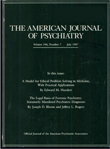This effort can be divided arbitrarily into three components consisting of a theory, the data supporting it, and practical clinical applications. The theory, in a somewhat simplified version, is that separation, real or imagined, represents an extraordinarily severe trauma to an infant. This trauma, if severe enough, alters the child's biological and psychological development and predisposes that child to a risk of flashbacks to the earlier developmental period of the initial trauma. Posttraumatic stress disorder is offered as a model for the mechanisms involved in all serious mental disorders. The flashback is particularly damaging when these initial traumatic events occur early in development because it involves a reversal to the infantile brain development available at that time. With persistence of the presence of the infantile brain mechanisms there is a disuse atrophy of the adult brain areas. The flashback is produced by a second severe trauma, which is both intense and similar to the initial trauma and produces a physiological and psychological return to the period of the initial trauma. Schizophrenia, according to this theory, involves an initial trauma before the age of 24 months. In an effort to support this theory, the authors look at the birth of a sibling as a trauma that can be placed precisely in time and that can be experienced by the older infant as extremely noxious.
According to the theory, schizophrenia involves a trauma during the first 18 months of life, schizoaffective disorder during the next 6 months of life, and depressive disorders during the period between 24 and 34 months of life. A pilot study performed by the authors in 1985 compared 60 residents of a halfway house with 60 normal subjects selected in a nonsystematic fashion. In this study group of 120, there were 20 individuals with siblings who had been born less than 18 months later. Of these 20 subjects, 17 were among the halfway house residents and only three were among the normal subjects. A second study, performed in 1994 and using 24 months as the cutoff point, found that subjects with siblings who had been born less than 24 months later showed auditory hallucinations. Sarnoff Mednick ran a sample of 6,000 Finnish patients with schizophrenia and found that a statistically significant number of that sample had siblings born less than 2 years later. These are the data supporting the theory.
A major statistical problem with the methodology is that women who have children closely spaced may differ in ways that are significant for the prevalence of psychosis, such as social class. The close spacing may even reflect illness in the mother. The close spacing certainly is consistent with a different assessment of reality and responsibility than found in parents who space their children further apart.
The data are intriguing, and the authors deserve credit for identifying these findings. Readers may differ sharply in their interpretation, but it would be best not to ignore the finding. Although we may differ as to the meaning, we should at least acknowledge our debt to those who have forced us to think about the data.

